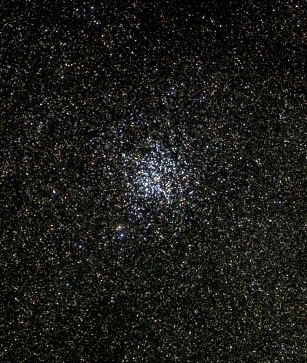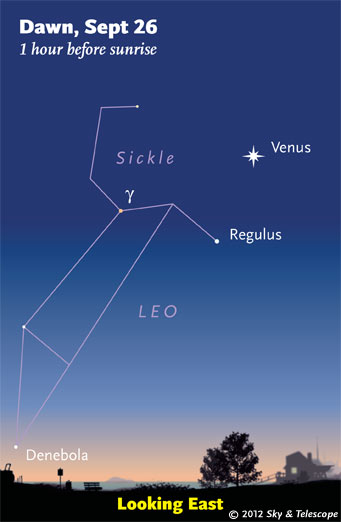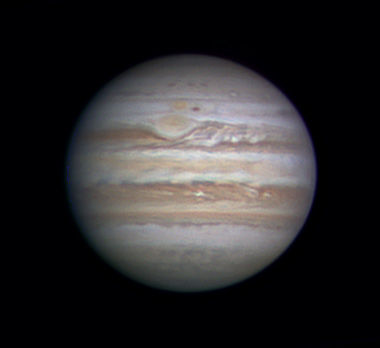
M11, the Wild Duck Cluster. Click image for closeup view.
Sean Walker
Friday, Sept. 21
Saturday, Sept. 22

All week, watch Regulus and Leo creeping up on Venus in early dawn.
Sky & Telescope diagram
Sunday, Sept. 23
Monday, Sept. 24
Tuesday, Sept. 25
Wednesday, Sept. 26
Thursday, Sept. 27
Friday, Sept. 28
Saturday, Sept. 29
Want to become a better amateur astronomer? Learn your way around the constellations. They're the key to locating everything fainter and deeper to hunt with binoculars or a telescope.
For an easy-to-use constellation guide covering the whole evening sky, use the big monthly map in the center of each issue of Sky & Telescope, the essential guide to astronomy. Or download our free Getting Started in Astronomy booklet (which only has bimonthly maps).

The Pocket Sky Atlas plots 30,796 stars to magnitude 7.6 — which may sound like a lot, but that's less than one star in an entire telescopic field of view, on average. By comparison, Sky Atlas 2000.0 plots 81,312 stars to magnitude 8.5, typically one or two stars per telescopic field. Both atlases include many hundreds of deep-sky targets — galaxies, star clusters, and nebulae — to hunt among the stars.
Sky & Telescope
Once you get a telescope, to put it to good use you'll need a detailed, large-scale sky atlas (set of charts). The standards are the little Pocket Sky Atlas, which shows stars to magnitude 7.6; the larger and deeper Sky Atlas 2000.0 (stars to magnitude 8.5); and the even larger Uranometria 2000.0 (stars to magnitude 9.75). And read how to use sky charts with a telescope effectively.
You'll also want a good deep-sky guidebook, such as Sue French's Deep-Sky Wonders collection (which includes its own charts), Sky Atlas 2000.0 Companion by Strong and Sinnott, the bigger Night Sky Observer's Guide by Kepple and Sanner, or the classic if dated Burnham's Celestial Handbook.
Can a computerized telescope replace charts? I don't think so — not for beginners, anyway, and especially not on mounts and tripods that are less than top-quality mechanically (able to point with better than 0.2° repeatability). As Terence Dickinson and Alan Dyer say in their invaluable Backyard Astronomer's Guide, "A full appreciation of the universe cannot come without developing the skills to find things in the sky and understanding how the sky works. This knowledge comes only by spending time under the stars with star maps in hand."
This Week's Planet Roundup

Jupiter's Great Red Spot had recently crossed the planet's central meridian when S&T's Sean Walker took this image on the morning of September 13th. South is up. Note that ring-like Red Spot Junior (Oval BA) is now passing just south of the Great Red Spot with no apparent effect on either of them. Walker used a 12.5-inch Newtonian telescope with a DMK 21AU618 astro video camera.
See our article Big Breakout on Jupiter on the dramatic growth this year of the North Equatorial Belt (below center here).
S&T: Sean Walker
Mercury is hidden deep in the sunset.
Venus (magnitude –4.2, crossing from Cancer into Leo) rises in darkness around 3 or 4 a.m. daylight saving time, emerging above the east-northeast horizon two hours before the first glimmer of dawn. By dawn it's blazing high in the east.
Look to Venus's lower left for Regulus, much fainter. It's rising up toward Venus day by day. They'll have a very close conjunction on the morning of October 3rd.
Mars (magnitude +1.2, in Libra) remains low in the southwest in evening twilight. Don't confuse it with twinklier orange Antares ("Anti-Mars") well to its left or upper left. The gap between them shrinks from 20° to 16° this week.
Jupiter (magnitude –2.5, in Taurus) rises in the east-northeast around 10 or 11 p.m. daylight saving time. Once it's clear of the horizon, look for fainter orange Aldebaran twinkling 8° to its right and Beta Tauri (Elnath) a trace farther to its left. By the beginning of dawn, this lineup-of-three stands high and diagonal in the south.
Saturn (magnitude +0.8, in Virgo) is sinking away into the sunset far to the lower right of Mars.
Uranus (magnitude 5.7, at the Pisces-Cetus border) and Neptune (magnitude 7.8, in Aquarius) are well up in the southeast during evening. This week Uranus is very close to the similarly bright, but differently colored, star 44 Piscium; see our article Uranus's Rare Close Encounter. The two appear closest on the American evenings of Saturday and Sunday September 22nd and 23rd, when they're 1.4 arcminutes apart. Finder charts for Uranus and Neptune.
All descriptions that relate to your horizon — including the words up, down, right, and left — are written for the world's mid-northern latitudes. Descriptions that also depend on longitude (mainly Moon positions) are for North America. Eastern Daylight Time (EDT) equals Universal Time (also known as UT, UTC, or GMT) minus 4 hours.
Like This Week's Sky at a Glance? Watch our weekly SkyWeek TV short. It's also playing on PBS!
To be sure to get the current Sky at a Glance, bookmark this URL:
http://SkyandTelescope.com/observing/ataglance?1=1
If pictures fail to load, refresh the page. If they still fail to load, change the 1 at the end of the URL to any other character and try again.
 0
0
Comments
You must be logged in to post a comment.